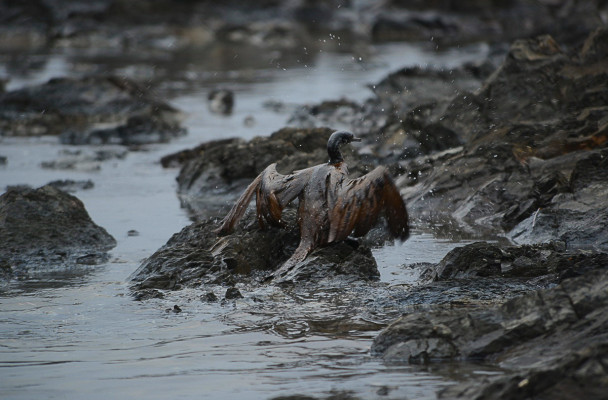The voyage of the Crystal Serenity and the risks of Arctic shipping
Blog
Heavy fuel oil is considered the most significant threat to the Arctic. So why isn’t it banned yet?
Heavy fuel oil (HFO) is the bottom of the barrel leftovers from the oil refining process. It is incredibly viscous; at room temperature, it can be the consistency of peanut butter. Few engines can burn HFO – its low quality and gumminess prevents its use in all transport modes, with the exception of marine. Indeed, HFO is the preferred fuel for the marine shipping industry because it’s cheap, widely available, and large marine engines are built to handle it. From cruise ships to container vessels, HFO fuels the commercial marine industry.
Recently, the use of HFO in sensitive ecological areas like the Arctic has come under fire from environmental groups, driven in part by this year’s historic journey of the 1070-passenger Crystal Serenity luxury cruise ship through the Northwest Passage. Neither the Crystal Serenity, nor her escort vessel, the RRS Shackleton, are burning heavy fuel oil on this trip, although normally they would. Given the potential consequences of an HFO spill in the Arctic, they’re smart to avoid it.
We’ve all witnessed the horrific environmental damage caused by oil spills (Exxon Valdez, anyone?). And HFO would be particularly difficult to clean up if spilled in the Arctic: HFO doesn’t readily disperse or breakdown in the marine environment and it has a tendency to stick to surfaces like sea ice or sink and emulsify in sea water (rather than floating on the surface or evaporating off). Further, the Arctic is remote and subject to extreme weather conditions, making clean up not only challenging and costly, but also dangerous.

An oiled seabird resting onshore, following a spill of HFO off the coast of Russia in November of 2015. Photo courtesy of Sakhalin Watch and Club Boomerang.
It’s hard to overstate the risk of HFO to the Arctic environment. In fact, HFO has been described as the “the most significant threat from ships to the Arctic marine environment.” And world leaders are paying attention. In their March 2016 joint statement on climate, energy, and Arctic leadership, President Obama and Prime Minister Trudeau stressed the need to determine “how best to address the risks posed by heavy fuel oil use and black carbon emissions from Arctic shipping.”
What’s frustrating for some advocates is that the International Maritime Organization (IMO), the governing body for all international shipping, has already banned both the use and carriage of HFO in the waters surrounding Antarctica. So why protect one pole and not the other?
The answer lies in simple economics. Unlike Antarctica, the Arctic is home to commercial shipping ports that transport commodities to and from Arctic communities. These businesses are worried that banning HFO use in the Arctic would seriously harm their bottom lines.
Take the case of Alaska’s Red Dog Mine. Red Dog is an open pit zinc and lead mine more than 100 miles north of the Arctic Circle that supports roughly 700 employees and their families. Once excavated, the zinc and lead are transported 52 miles to the coast, where the materials are loaded onto barges that are pushed by tugs to foreign-flag bulk carriers waiting three nautical miles offshore (any closer and the ships have to enter and clear U.S. Customs). The tugs are small and they run on diesel. But the bulkers are big and they run on HFO. Our research shows that 44 ships serviced the Red Dog Mine in 2015: 12 U.S.-flag tugs (diesel); 2 U.S. Coast Guard vessels (diesel); 2 foreign-flag tankers (heavy fuel oil); and 28 foreign-flag bulk carriers (heavy fuel oil).
Would businesses like the Red Dog Mine fold if the use of HFO is prohibited in the Arctic? Not likely. While some will rightly point out that HFO is the cheapest fuel available and burning cleaner fuel is more expensive, we’re in a period of incredibly low marine fuel prices. The mine has been open since 1989. Since then, marine fuel prices have spiked and plummeted, ebbed and flowed, but the mine has operated continuously.
When we know that heavy fuel oil is the biggest threat to the Arctic marine environment, when we know that heavy fuel oil is dangerous to human and environmental health, when we know that heavy fuel oil is already banned in the Antarctic, shouldn’t we seriously consider prohibiting its use in the Arctic? Ongoing dialogue at the IMO’s Marine Environment Protection Committee (MEPC) provides a glimmer of hope for eliminating, or at least reducing, heavy fuel oil use in the Arctic. The 70th session of MEPC, coming up this October, is expected to tackle two topics relevant to heavy fuel oil use in the Arctic: a global marine fuel sulfur cap, which would greatly reduce the amount of HFO used in the Arctic by large cargo ships; and whether or not HFO use in the Arctic should be placed on the formal MEPC agenda.
In our next blog post, we’ll continue to track Crystal Serenity’s voyage as it makes its way down the Eastern North American coast and discuss another great risk from ships burning heavy fuel oil in the Arctic: black carbon.
